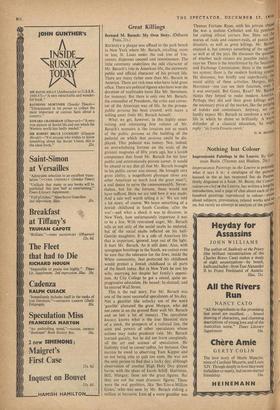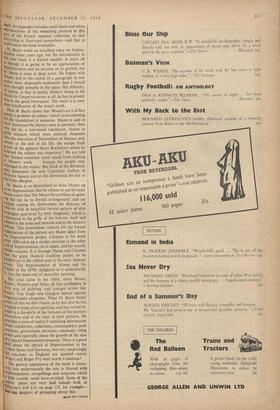Nothing but Colour
Impressionist Paintings in the Louvre. By Ger main Bazin. (Thames and Hudson, 280 Impressionist Paintings in the Louvre is preciselY what it says it is: a catalogue of the pictures housed in the at last reopened Jeu de Pantile, thinly disguised as a book. M. Bazin, the Conser" vateur-en-chef at the Louvre, has written a IengthY introduction, and a page of chat about each of the hundred paintings reproduced in colour—notes about subjects, provenance, related works and s° on, but rarely an attempt at analysis of the picture 'NW. An appendix includes small black-and-white reProductions of the remaining pictures in this Part of the French national collection, so that e.verYthing is illustrated somewhere—and that in itself makes the book invaluable.
M. Bazin wrote an excellent essay on Impres- sionism some years ago, but the introduction to this new book is a fearful muddle. It starts off as though it is going to be an appreciation of l_nlpressionism and an account of its growth, but Bazin is soon in deep water. He begins with Manet, and in the course of a paragraph or two Makes more disputable statements than I should nave thought possible in the space. His difficulty, ?f_ course, is that to justify Manet's being in the 14„,. lade l'Impressionistne at all, he has to present °Int as the great forerunner. The result is a corn- Mete falsification of the artist's work.
Thus M. Bazin claims that 'Manes art is in fact 11.3ItrelY a problem of colour,' which (even allowing r the translation) is nonsense. Menet is said to 'lave 'destroyed the literary taint in pictures'; then whY did he; a convinced republican, choose to Paint subjects which were political dynamite (like the execution of Maximilian of Mexico, and, alnlust at the end of his life, the escape from ,Prison of the agitator Henri Rochefort) unless he nelieved the subject was important? We are told that 'human emotions never result from looking
Manet's work . . . because his people only ',longed to the studio.' But think of the Barmaid,
dominates the new Courtauld Gallery in woburn Square just as she dominated the bar at IL Folies Bergere. M• Bazin is so determined to dress Manet up a' lin Impressionist that he refuses louse his eyes; 1.1C can assert that 'for Menet the problem of paint- did not lie in formal arrangement' and yet 1,nelade among his illustrations the Balcony of '868-69 with its beautiful formal pattern of slim rectangles quartered• by their diagonals, which is announced in the grille of the balcony itself and Lech, ued in the arms and parasols and in the shutters "enind. This tremendous conceim for the formal organisation of the picture sets Manet apart from theimpressionists proper. Cezanne in his work 'liter 1880 takes up a similar position at the other 'nd of Impressionism, so to speak, and for exactly Ilar reasons. It is through Manet and Cdzanne ILhat the great classical tradition passes, to be I Handed on to the cubists and to the early abstract sts. The Impressionism of . Monet and his 'lends in the 1870s, delightful as it undoubtedly k, Was the dead end of naturalist painting. I The crisis came in the 1880s, when Monet, ,;,ettoir, Pissarro, and Sisley all lost confidence in way of painting, and younger artists like ?enrat, Van Gogh and Gauguin turned against 'Inpressionism altogether. What M. Bazin thinks Thout all this we don't know, as by this time he has stunned writing about painting, and has turned in- stead to a chronicle of the fortunes of the painters themselves and of the fates of their pictures. He P,ruvides a mass of useful if confusing information aoout exhibitions, collections, contemporary press reactions, government decisions, constantly rising 13rice5 and especially about the growth of the idea ,(),` a special Impressionist museum. There is a good ',?al about the spread of impressionism in the united States and Germany, but very surprisingly !he reactions in England are ignored—surely Slekert and Roger Fry were worth a mention? The general appearance of the book is attrac- tive, but unfortunately the text is littered with lnistranslations, misspellings and misprints which a little trouble could have avoided. Some of the _eolour plates are very bad indeed—look at ‘2Lizanne's Still Life on page 225, for examPle- °tit one despairs of protesting about this.
ALAN BO'NNESS







































 Previous page
Previous page